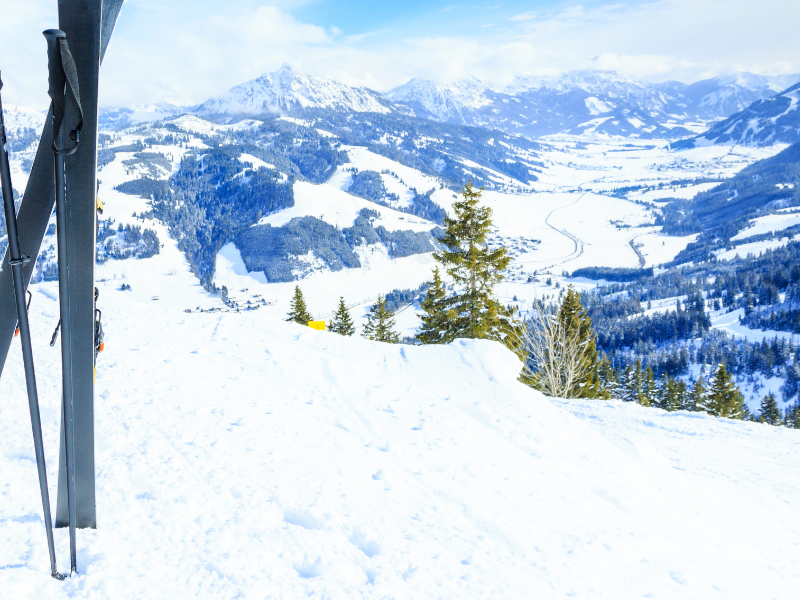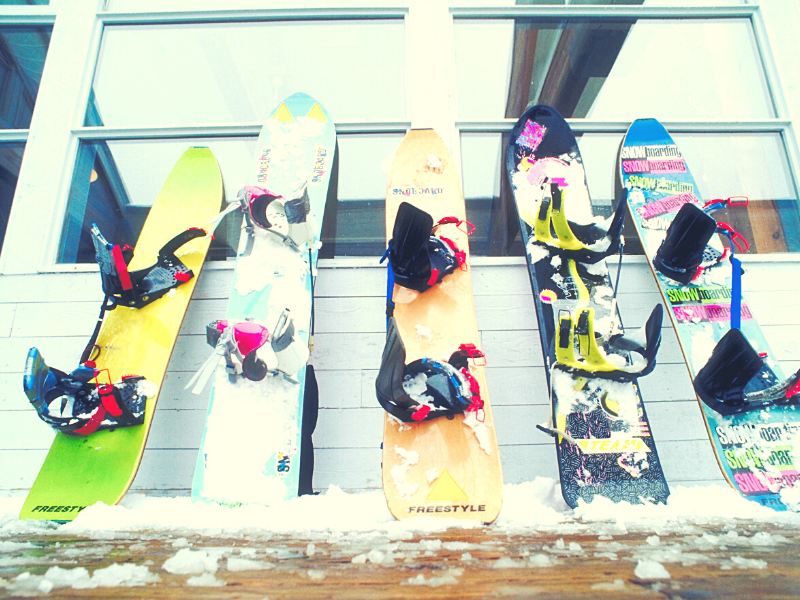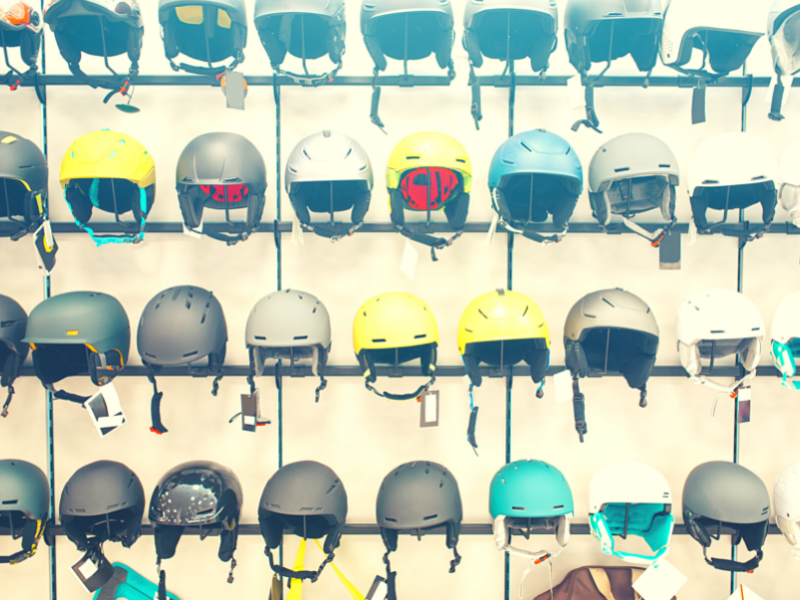How Tall Should Ski Poles Be? The Ultimate Size Guide
While some skiers forego them, most prefer the stability and balance of ski poles. If you’re interested in purchasing a set yourself, or if you're trying to gauge if you currently have the right size, you might be wondering just how tall ski poles should be.
The height of ski poles is determined by a skier's own height. For example, skiers who are five feet tall need 42-inch ski poles while skiers who are six feet, four inches tall need 54-inch poles. The scale of ski poles to a skier's relative height is specific to the inch and centimeter.
In today’s ultimate size guide for ski poles, we’ll help you get all your measurements prepared so you can buy a pair of ski poles commensurate to your height.
What Are Ski Poles For?
Ski poles are used for balance and propulsion on downhill, cross-country, and back-country skiing. Poles may have baskets at the bottom to prevent them from sinking into soft snow, and rubber or carbide tips to provide traction.
Though they are seen as an optional skiing tool, the majority of skiers still use ski poles because of a few key advantages that come with them.
- Support: Ski poles can be leaned on for support, which is great when you’re skiing on uneven or icy terrain.
- Balance: They also act as a counterbalance to your upper body weight and help you keep your center of gravity over your skis.
- Propulsion: When properly used, ski poles can also give you an extra push
- Rhythm: Skiing with poles can also help establish a rhythm, which can make skiing feel more natural and fluid - perfect for beginners.
- Extra Hands: Some skiers (my lazy self included) like to use ski poles to close buckles or remove packed snow off the boots and bindings.
Ok so maybe that last one isn't a true advantage, but it certainly beats bending over to buckle your boots or clean some hard snow off your skis.
The 5 Types of Ski Poles
Ski poles come in several varieties and all are built with unique purposes in mind. So if you're in the market for new ski poles, definitely take the style of skiing you do into account - the height of ski poles won't matter if you try to take nordic poles on your downhill skiing trip.
The 5 types of ski poles include:
- Ski Racing Poles
- Nordic Ski Poles
- Powder Ski Poles
- Freestyle Poles
- Alpine Poles
Below, you'll find a summary of each type of ski pole, and which situation they're best suited for.

1. Ski Racing Poles
If you're the type of person who lives for the thrill of skiing downhill, then you should use ski racing poles.
- Light and Narrow: These poles are by far the lightest among all five, and they're quite narrow too, meaning less overall resistance.
- Speed: By reducing drag, this design feature gives skiers the advantage of a faster speed and potentially winning the first-place title, or just beating their friend down the mountain.
- Durability: But just because racing poles are lightweight doesn't mean they are delicate - quite the contrary. Ski racing poles are incredibly durable which allows racers to make fast and aggressive turns without the fear of snapping their poles. They also have smaller baskets specifically designed not to catch on gates. This ski pole didn't earn the name "racing" for nothing.

2. Nordic Ski Poles
Nordic ski poles, are built for flatter terrains than your average set of poles, which as you might imagine is part of the reason they are used in the sport of cross-country and interchangeably referred to as cross-country poles.
- Long, Thin, and Pointy: They're long, slender, and have a spiked end for easy pushing through the snow. The thin diameter and lightweight quality of Nordic poles are somewhat reminiscent of ski racing poles, but Nordic poles are not about speed.
- Portable: Nordic poles are not as durable as some of the other types of ski poles, but they make up for it in portability - most nordic ski poles are collapsible and easy to carry around.

3. Powder Ski Poles
Powder skiing is all about making fresh turns in the deep stuff, so it's only fitting that powder ski poles have a few features to help with that. Backcountry poles (another name for powder poles) are easy to spot because of their powder baskets.
- Wide Baskets: These are significantly larger than your standard pole basket and they're designed to keep your poles from sinking too deep into the snow. This comes in handy when you're making those big, sweeping turns and need to rely on your poles for balance. The baskets also tend to be a bright color so they're easier to spot if you happen to drop one in the snow.
- Shock Absorbing Shaft: Another feature of powder ski poles is that they're often made with a thicker, but softer shaft. This helps reduce vibrations when you hit something hard, like a tree branch, while skiing at high speeds.
- Adjustable: Powder ski poles are length-adjustable so that whether you’re skiing through deeper powder or only a light dusting, your skis are configurable to the weather.
- Not Versatile: Unfortunately, fresh powder isn't as readily accessible in certain areas, like if you live and ski mostly in wetter snow. So some skiers that don't hit powdery snow as often will opt for more versatile poles instead of powder ski poles.

4. Freestyle Poles
Skiing in the terrain park requires a different set of skills than skiing down an open mountain, so it's no surprise that there are poles designed specifically for this type of skiing, introducing freestyle poles, also referred to as park poles.
- Shorter Length: The first thing you'll notice about freestyle ski poles is that they're shorter than your average pole, and that’s so you don’t get tripped up on any nearby obstacles.
- Wide Baskets: Just like powder ski poles, freestyle ski poles have wide baskets to keep the pole from sinking too deep into the snow and to make them easier to spot if you drop them. Skiing a park is all about being lightweight on the snow, so a wider basket, just like snowshoes, helps disperse your surface area out, preventing heavier sinking into the snow.
- Durable: These poles are made to take a beating as you ski over jumps, rails, and boxes. The shaft is still thin to help with speed maintenance on flatter terrains, but even with a thinner shaft, freestyle poles don't sacrifice any durability.

5. Alpine Poles
Of all the skiing poles, alpine poles, or downhill, poles are the all-around workhorses of the ski pole world. They are the ones you’ll come across the most often because of their versatility.
- Versatility: Alpine poles can be used for a variety of different skiing styles, including racing, carving, all-mountain, and even backcountry. In other words, they can handle a wide range of skiing terrains without compromising the quality of skiing.
- Basket Size: The baskets on these poles are medium-sized, which helps with not sinking too deep into the snow, but they're also not as wide as powder or freestyle baskets - this makes them more adept at adapting quickly to thick snow or powder.
- Shape and Length: The shaft of an alpine pole is straight - often with a slight taper near the bottom. They are the quintessential image of a ski pole that most people immediately think of. Unlike nordic, backcountry, and freestyle poles, alpine poles come in a fixed length and they're not adjustable. This is because downhill skiing requires more precise pole planting, which is only possible with the correct pole length.
You now know the different types of ski poles, so it's time to make your ski pole decision, accounting for terrain and skiing style.
Once you've done that, move on to the next section, where you'll find exact ski pole height recommendations.
What Size Ski Poles Do I Need? How Do You Choose a Ski Pole Length?
If you’re like most people, you’ve probably never given much thought to the size of your ski poles. However, if you want to get the most out of your skiing experience, it’s important to choose the right size poles for your height.
Just like the top of this article mentioned, all you need is your height to find the perfect pole length.
Whether you share your height in feet or meters, we've got you covered with a handy chart to determine which ski pole length is right for you.
How to Measure Your Current Ski PolesMaybe you've landed here because you're uncertain if your current ski poles are the right size. If that's the case, don't worry, it's an easy task.
If you can’t eyeball 34 inches, which most of us can't, then it’s best to pull out the measuring tape.
But before we can offer pointers on how to measure a ski pole, we want to quickly go over the anatomy of your average ski pole so you know what to measure and what not to.
Anatomy of a Ski Pole - From Top To Bottom
- Grips: These are the pole’s handles. Grips come in all different sizes and materials designed to maximize your comfort and enhance your natural hand grip on the ski pole.
- Straps: Ski straps are the loops of fabric that go around your wrist, loosely "attaching" you to the ski pole, and keeping your grip close by even if you lose hold.
- Shafts: Each ski pole has one shaft, which is the cylindrical body of the pole that runs from the grip to the basket. Most ski poles are made from aluminum or a composite material like carbon fiber.
- Snow Basket: Mentioned in all of the five ski pole types, these are disc-shaped items that run perpendicular to the shaft of your ski pole, and can be found toward the bottom of the skis. They can resemble the shape of a snowflake.
- Tips: The very bottom of your ski poles are called the tips, and they come in all different shapes and sizes depending on the terrain you’re skiing.
Okay, so now that you know which parts are which, it’s time to get measuring your ski poles.
Measuring Ski Poles in 3 Easy Steps
Step 1 – Put on Your Ski Boots
Although the thought of wearing ski boots when you’re not going skiing may seem strange, it’s to help with measurement accuracy.
After all, you’re going to wear your ski boots when you go skiing with your new ski poles.
If your ski boots aren’t available, then a pair of shoes with a thicker sole or something semi-comparable to the thickness of a ski boot will do.
Step 2 – Hold onto the Poles
Next, grab your ski poles and hold them as though you were going skiing.
Have a friend or family member take the measuring tape and measure the length of the ski pole shaft.
They should start right at the top of the grip (handle) and go all the way to the bottom of the tip. Record the measurement.
Step 3 – Double Check - Upsize or Downsize
You've got the magic number, now let's check how accurate it is. Here’s a handy little trick that will customize your ski pole length to your stance and posture; leading to downsizing or upsizing your ski pole length.
- Hold the poles upside down this time so the grips are on the floor and the tips are in the air.
- Now grab the poles beneath the basket. The tip of your thumb should graze the basket.
- Have your friend or family member look at the way your elbow is bent - more specifically the angle your elbow creates.
Is your elbow acute and not quite at 90 degrees? You need a pole slightly shorter than the one you’re holding.
Is your elbow approximately 90 degrees? Then you’ve got the correct length.
What if your elbow is obtuse and extended more than 90 degrees? Then your current ski pole length is too short - it's time to size up.
Measuring Yourself For Ski Poles
If you already owned ski poles, then you've now successfully measured your ski pole length. But for those without ski poles, let's get you to get back in the fold, and join the current ski pole owners -
it’s time to measure how tall you are.
Everyone knows roughly how tall they are, we've been saying it for years. But when was the last time you really measured your height or had someone do it for you? More importantly, when was the last time you measured your height while wearing ski boots?
Cricket noises.
It's time to put those crickets to rest and answer the question.
In this instance, wearing ski boots is not optional, so find your boots and put them on. If you haven't purchased yet, head to the store and try your desired pair on. Then grab a family member or friend and continue with the following:
- Stand on a flat surface.
- Keep your arms by your sides.
- Have a friend or family member pull out a flexible measuring tape.
- Stretch the tape from the crown of your head to the bottom of your feet.
Use this new height as your height going forward when shopping for ski equipment such as poles. Your height in your ski boots will be slightly taller than when you forego the boots.
Reference the table found earlier in this article for the recommended pole size based on your newfound growth spurt in ski boots.
Is It Better to Go Shorter or Longer on Ski Poles?
When stuck between two sizes, it's typically better to go for a shorter ski pole than a longer one. There are risks to oversizing and undersizing ski poles though - if too long, your balance will suffer, too short and you won't be able to push off the poles. One solution may be adjustable ski poles.
Sometimes, measuring for your ski pole length is fairly cut and dried. In other cases, you can find yourself between two sizes and unsure which is better for you.
If your poles are too long, then when you swing them forward, the pole will get stuck in the snow. Your balance falls out of whack as you have to rotate your body to accommodate.
Should your ski poles be too short, then pushing off the poles is going to be very difficult. Your performance will suffer, as will your range of motion.
Bearing all that in mind, when stuck between two sizes, is it better to go for longer ski poles or shorter poles?
The answer is the shorter pole.
Shorter ski poles are easier to control and don't require as much energy to keep them going where you want them. They also give you more range of motion, which lets you go faster.
Longer ski poles can be unwieldy and may get stuck in the snow. And in most cases, sacrificing propulsion for better balance is an easy answer, which is exactly what choosing a shorter ski pole over a longer ski pole does.
If you’re still in doubt, you can always buy a set of adjustable ski poles. This way, you can customize them to the perfect height.
Don't Overlook Correct Ski Pole Height
When shopping for skiing equipment, most of the thought, attention, and consideration goes into the skis themselves and not nearly as much into the poles.
The right set of ski poles can enhance one’s performance on the slopes, providing balance, rhythm, support, and easy liftoff.
Your height will always be the easiest gauge to determine how long your ski poles should be. Remember to measure your height when wearing your ski boots so the measurement is more accurate.
Also, when in doubt, size your ski poles down instead of up!



